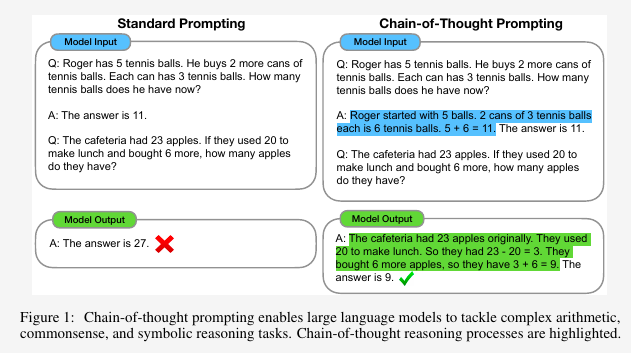Import libs and functions (click to toggle the content)
import yaml
import openai
from openai_utils import chat_completionJuly 26, 2023
Chain-of-Thought (CoT) [1] is a technique that enhances the reasoning capabilities of large language models (LLMs). It breaks down complex tasks into multiple intermediate reasoning steps to help LLMs to reach the final answer. It uses LLMs’ capability to do few-shot prompting for reasoning taks. The basic idea is to include chain of thought example(s) in prompting, as illustrated in the following figure:

Source: Wei et al. [1]
The authors listed several attractive properties of CoT prompting:
Three key observations from their math reasoning experiments:
The paper claims that CoT prompting is applicable to commonsense reasoning problems involving reasoning about physical and human interactions under the presumption of general background knowledge. Experiment results show that CoT prompting improves the performance of PaLM on all tasks, with PaLM 540B achiving new SoTA results on StrategyQA, and outperforming an unaided sports enthusiast on Sports Understanding.
The authors did two toy tasks for symbolic reasoning: last letter concatenation and coin flip. They are simple for humans but potentially challenging for LLMs. Each task has both in-domain and out-of-domain test sets. Their experimental results indicate that CoT prompting allows LLMs to perform challenging symbolic reasoning tasks, and able to handle more reasoning steps for inference-time inputs. CoT prompting also leads to almost 100% solve rates for PaLM 540B on the in-domain test sets, and upward scaling curves for the out-of-domain test sets.
········prompt = """
Question: John found that the average of 15 numbers is 40. If 10 is added to each number then the mean of the numbers is?
Answer Choices:
(A) 50
(B) 45
(C) 65
(D) 78
(E) 64
```yaml
Choice: A
```
Answer the following question using the given answer format:
Question: A grocery sells a bag of ice for $1.25, and makes 20% profit. If it sells 500 bags of ice, how much total profit does it make?
Answer Choices:
(A) $275
(B) $150
(C) $225
(D) $250
(E) $125
Answer Format:
```yaml
Choice: [Letter of your choice only]
```
"""
messages = [
{'role': 'user', 'content': prompt}
]
response, _ = chat_completion(messages)
print(response)Choice: (C) $225The answer is wrong. The correct answer should be (E).
prompt = """
Question: John found that the average of 15 numbers is 40. If 10 is added to each number then the mean of the numbers is?
Answer Choices:
(A) 50
(B) 45
(C) 65
(D) 78
(E) 64
```yaml
# Reasoning: Profit per bag = 1.25 * 0.20 = 0.25 , Total profit = 500 * 0.25 = 125 , Answer is A
Choice: A
```
Answer the following question using the given answer format:
Question: A grocery sells a bag of ice for $1.25, and makes 20% profit. If it sells 500 bags of ice, how much total profit does it make?
Answer Choices:
(A) $275
(B) $150
(C) $225
(D) $250
(E) $125
Answer Format:
```yaml
# Reasoning: [Provide your reasoning here]
Choice: [Letter of your choice only]
```
"""
messages = [
{'role': 'user', 'content': prompt}
]
response, _ = chat_completion(messages)
print(response)# Reasoning: Profit per bag = 1.25 * 0.20 = 0.25 , Total profit = 500 * 0.25 = 125 , Answer is E
Choice: E